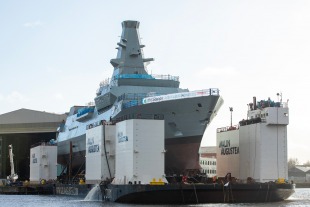Anti-submarine warfare frigate HMS Glasgow (F88)
Basic information
Ship measurements
Machine
- Rolls-Royce MT30 gas turbine
- 4 * MTU diesel generators
- 2 * electric motors
Personnel
Combat assets
- Type 997 Artisan 3D radar
- Kelvin Hughes Ltd SharpEye navigation radar
- Sonar 2087 (towed array sonar)
- Ultra Electronics Type 2150 bow sonar
- SCOT-5 satcom
- IRVIN-GQ DLF decoys
- Missiles :
- 48-cell VLS Sea Ceptor anti-air missiles
- 24-cell Mark 41 VLS for: Tomahawk, ASROC and anti-ship missiles
- Guns:
- 1 * 5-inch 62-calibre Mk 45 naval gun
- 2 * 30 mm DS30M Mk2 guns
- 2 * Phalanx CIWS
- 2 * miniguns
- 4 * general purpose machine guns
- Wildcat, armed with;
- 4 * anti-ship missiles, or
- 2 * anti-submarine torpedoes
- AgustaWestland Merlin, armed with;
- 4 * anti-submarine torpedoes
HMS Glasgow is the first Type 26 frigate to be built for the United Kingdom's Royal Navy. The Type 26 class will partially replace the navy's eight Type 23 frigates, and will be a multi-mission warship designed to support anti-submarine warfare, air defence and general purpose operations.
The ship is being assembled on the River Clyde in Glasgow. The first steel was cut for Glasgow in July 2017 with the ship expected to be delivered in 2024 and operational in about 2026. In January 2018, work started on the second hull section.
In January 2020, the Royal Navy announced that the ship was more than halfway through construction. In July 2020, the Royal Navy announced that work on the final section of Glasgow has started.
On 18 April 2021, the fore section of the ship moved out from its building shed on the Clyde, and on 1 May 2021 was joined with its aft section for the first time. The MOD envisaged her entry into service as 2026 but this could be 'brought forward' by one year to 2025.
- Comments
 en
en ru
ru uk
uk



 Royal Navy
Royal Navy